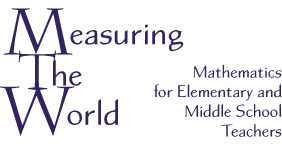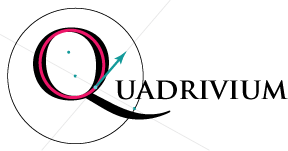

Measuring the World
Mathematics for Elementary and Middle School Teachers
by Susan Addington and David Dennis
Table of Contents
Introduction
Chapter 1. Measurement without numbers
1.1. Comparing areas
A. What is an attribute? What is a quantity? Greater than, less than,
equal to.
B. What is area? Rules for area
C. Dissection
1.2. Comparing lengths
A. What is length?
B. Methods of comparing lengths; adding lengths
1.3. Volume
A. Volume and some types of 3-dimensional objects
B. Adding and subtracting volumes
1.4. The size of a set
A. Discrete sets
B. Counting without numbers
One-to-one correspondence
C. Adding the sizes of sets
1.5. Weight and mass
A. Weight, mass, and measuring devices
1.6. Culminating activity (and introduction to Ch. 2)
A. Units of measure for length, area, volume
B. Volumes of boxes
Chapter 2. Numbers and operations
2.1. Units and numbers
A. Quantity with unit -> number
B. Other quantities and other uses of numbers
C. Concrete and abstract numbers
D. Standard and nonstandard units for quantities
E. The number line, real numbers and integers
F. Systems of units for the same quantity, converting units
G. Indirect measurement
2.2. Fractions with the length model
A. Fractional units and unit fractions
B. Systems of fractions using the length model
Binary fractions: definitions, comparing, simplifying
Common fractions: definitions, comparing, simplifying
Decimal fractions: definitions, comparing, simplifying
C. Comparing fractions; benchmark fractions
D. Rational numbers
2.3. Fractions, continued
A. Other models for numbers
B. Length and length manipulatives
C. Area and area manipulatives
D. Volume and volume manipulatives
E. Discrete sets and discrete manipulatives
F. Unitizing and reunitizing
G. Other uses for fractions: functions and operators
2.4. Addition
A. Ideas of addition
B. Length models of addition
Cuisenaire rods
Number line with vectors
Vectors in the plane and space
C. An area model of addition of fractions
E. Functions, tables, graphs
F. Properties of addition
G. Addition and calculators
2.5. Subtraction
A. Ideas of subtraction
Take away
Missing addend
Comparison, difference, change
Cancelling
Adding the opposite
B. Length models for subtraction
C. Properties (and non-properties) of subtraction
D. Applications of subtraction
Measuring volumes by subtraction
Measuring areas by subtraction on a grid
Approximate numbers, tolerances and error in measurement
E. Vectors, addition and subtraction
F. Subtraction and calculators
2.6. Division
A. Ideas of division
Sharing; dealing out
Measurement; repeated subtraction
Division as a fraction
Division as a ratio
B. Division and units
C. Dividing fractions
D. More examples
E. Division with 0
F. Division and calculators
2.7. Multiplication
A. Ideas of multiplication
Multiplication as scaling: stretching or shrinking
Multiplication as change of unit
Multiplication as the area of a rectangle
Multiplication as repeated addition
Multiplication as counting sets of sets, and the array model
Multiplication as a function or operator
B. Multiplication and units
C. Multiplying fractions
D. Properties of multiplication
E. Multiplication on a calculator
Chapter 3. Algorithms for arithmetic
3.1. Systems of units and place value
A. Measuring with combinations of units
B. The base 10 place value system for whole numbers
C. Notation systems in other cultures
Roman numerals and counting boards
The abacus
Mayan numeration (optional)
Babylonian numeration
D. Fractions and place value: decimals and sexagesimals
3.2. Algorithms for addition and subtraction
A. Algorithms for adding whole numbers
Ingredients:
Combining like units
Regrouping
Learning the 1-digit addition facts
Right to left addition
Left to right addition
Partial sums
Add on
B. Algorithms for subtracting whole numbers
Right to left subtraction
Left to right subtraction
Partial differences
Add up
C. Adding and subtracting decimal fractions
3.3. Algorithms for multiplication
A. Ingredients
The distributive property
The commutative property of multiplication
The associative property of multiplication
Multiplying by 10 in the base 10 system
Learning the 1-digit multiplication facts
B. Five methods for multiplying whole numbers
Area/rectangle method
Grid table method
Partial products method
Standard U.S. method
Lattice method
C. Multiplying decimals
3.4. Algorithms for division
A. Repeated subtraction algorithms
B. Transition to long division
C. Long division with decimals
D. Decimal representations of common fractions
3.5. Approximate numbers
A. Significant figures
B. Rounding
C. Arithmetic with approximate numbers
Addition and subtraction
Multiplication and division
Square roots
3.6. Signed numbers
A. Interpretations of negative numbers
B. Addition and subtraction
C. Multiplication and division
D. Patterns and properties of operations with signed numbers
3.7. Algorithms for fraction arithmetic
[Review and tying ideas together]
Chapter 4. Multiplicative thinking with real numbers
4.1. Indirect measurement with multiplication and division [Introductory activities]
Managing units
Area and volume
Ratio quantities
Measuring other quantities using weight/mass
The principle of the lever
4.2. The syntax of multiplication and division
A. Syntax and symbols
B. More ideas of division
C. Division and multiplication as inverse functions
D. Chains of several multiplications and divisions
E. Factoring
F. Division as missing-factor multiplication
G. Properties of multiplication and division, order of operations
H. Canceling in fractions
I. The syntax of units
J. Further calculator and non-calculator techniques
4.3. Ratios
A. Definitions and examples of ratios
Part/whole ratios
Part/part ratios
B. Representations of ratios
Pictures
Parallel number lines
Tables
Graphs and charts
Algebraic expressions and equations
C. Additive methods for working with ratios (for beginners)
D. Multiplicative methods for working with ratios
E. Algebraic methods for working with ratios
4.4. Percent
A. Percent definitions and examples
B. Representations of percent and computational methods
C. Percent of, percent more than, percent less than
D. Percent as comparison
4.5. Linear functions and graphs
A. Cartesian graphs
B. Slope of a graph
C. Comparing ratios
A, Interpreting graphs
B. Making graphs with and without technology
C. Problem solving: two functions of one variable
4.6. Arithmetic revisited
A. The distributive property in arithmetic
B. Mental arithmetic: shortcuts using multiplicative thinking
Chapter 5: Multiplicative thinking with whole numbers
5.1. Counting without numbers
Rhythm and dance activities
Art activities
Venn diagrams
5.2. Primes and factoring
A. Terminology
B. Models of factoring
C. Methods for factoring
Repeated gozintas
Tree diagrams
Number cards
D. Unique factorization
E. The Primes Game
F. Mental arithmetic and technology in number theory
5.3. Multiples
A. Representing multiples
B. The Sieve of Eratosthenes
C. Common multiples of several numbers
D. Multiples and prime factorizations
E. Mental arithmetic and multiples
F. Arithmetic and the least common multiple
5.4. Divisors
A. Efficient factoring methods
B. The greatest common divisor of several numbers
Self-explanatory method
Prime factorization method
Relation between LCM and GCD
The GCD in arithmetic and algebra
C. Geometry and GCDs
The area model, again
The Euclidean algorithm
D. General facts about divisors
E. Technology for divisors
5.5. Divisibility tests
A. 10s and 2s
B. 3s and 9s
C. 11s
D. 7s (optional)
E. Even more efficient factoring methods
5.6. Arithmetic revisited
A. Equivalent fractions
B. Efficient algorithms for fraction arithmetic
Chapter 6. Geometry
6.1. Introductory activity: regular polyhedra
6.2. Plane geometry without numbers
A. Polygons
B. Diagrams for organizing concepts
Concept maps
Venn diagrams
C. Geometric constructions
Graph paper or lined paper
Paper folding (with and without cutting)
D. Transformations and Symmetry
E. Software for plane geometry
6.3. Angles
A. Ideas of angle
Rotation
Opening between two rays
B. Units for measuring angles
C. Comparing, adding, and subtracting angles
D. Angles in polygons
E. Angles in navigation vs. angles in geometry
F. The Logo computer language
6.4. Circles
A. Definitions
B. Geometric constructions with straightedge and compass
C. Circumference of a circle
D. Area of a circle
E. Fractions and percents with circles
F. Other facts about circles
Figures inscribed in circles
Tangents and secants
Symmetry
6.5. Geometry in three dimensions
A. Types of 3-dimensional objects
B. Hollow objects from nets
C. Solid objects
Building figures out of smaller solid objects
Prisms by layers or extrusion
Solids of revolution
Software for 3D geometry
D. Other topics in 3-dimensional geometry
Conic sections
Symmetry of 3-dimensional objects
6.6. Scaling: stretching and shrinking
A. Examples of scaling
B. Scaling without numbers
Scaling with a projector
Judging scaling by eye
C. Scaling by changing lengths
Dilations: scaling geometric objects
The Picture of the Day
D. Scaling by changing units
6.6. Similarity
A. Similar figures
B. Scale factors, area factors, and volume factors
C. Similar triangles
6.7. The Pythagorean theorem
A. Squares and square roots
B. The Pythagorean Theorem
As a statement about areas
As a statement about lengths in a right triangle
As a statement about the distance between points with coordinates
C. Proof of the Pythagorean Theorem
D. Converse of the Pythagorean Theorem
6.8. Measuring using formulas
A. Formulas from dissection
B. Base times height and related formulas
C. Formulas and units
D. Formulas and transformations
Scaling: uniform scaling, non-uniform scaling
Shears and Cavalieri’s principle
Chapter 7. Algebraic Thinking
7.1. Four representations for thinking about functions
A. Tables
Functions of one variable
Problem solving by guess and check
Grid tables: functions of two variables
B. Graphs
Functions of one variable; problem solving with graphs
Graphs from grid tables: functions of two variables
C. Expressions and equations
What is a variable?
Writing expressions from guess and check tables
D. Flow charts
Problem solving with flow charts
7.2. Linear functions in two variables
A. Grid tables
B. Equations from grid tables
C. Graphs from grid tables
3-dimensional bar graphs
Surface graphs
Contour graphs
D. Functions that are like the addition table
E. Functions that are like the multiplication table
F. Problem solving: two equations, two unknowns; bilinear functions
7.3. Inverse proportions and the 1/x function
A. Ratio relations, inside out
B. Graphs
C. Problem solving
7.4. Exponential patterns and functions
A. Place value and the metric system, revisited
Multiplying and dividing by powers of 10
Scientific notation
B. Exponential functions
C. Percents as multipliers
D. Non-integer bases: growth and decay
E. Negative exponents
F. Fractional exponents and interpolation
G. Guess and check
H. Exponential functions and technology
7.7. Power functions and root functions
A. Definitions; Exponential vs. power functions
B. Differences in tables and graphs
C. Higher order differences
D. Inverse functions
Definitions, flow charts
Square root algorithms
7.8. Polynomials
A. Review: length and area models for numbers and operations
B. Algebra tiles and symbolic algebra
C. Adding, multiplying, and factoring with algebra tiles
D. Negatives and subtraction with algebra tiles
E. Completing the square with algebra tiles
7.9. Symbolic algebra
A. Equations without numbers
B. Equivalent expressions with a spreadsheet
B. Equivalent expressions with algebra tiles
C. Writing expressions
D. Simplifying expressions
E. Solving equations
7.10 Patterns and equations: recursive and closed form formulas
A. Recursive and explicit descriptions for sequences and functions
B. Sequences from geometry
Chapter 8. Measuring chance: probability and statistics
8.1. Measuring chance
A. Events
B. Sampling and proportion
8.2. Representing data
A. Graphs without numbers
Pictographs
Bean graphs
Venn diagrams
B. Distributions
8.3. Decision trees and probability
A. The syntax of the measurement of chance
B. Chains of choices
C. The laws of probability
8.4. Counting
A. Counting by grouping
The addition principle
The multiplication principle
Complements
B. Counting and diagrams
Organized list
Venn diagram
Grid table
Tree
C. Compensating for overcounting
The addition principle and subtraction
The multiplication principle and division
8.5. Combinations and permutations
A. Permutations
B. Combinations
C. Pascal’s triangle
Pascal’s triangle
The binomial theorem
8.6. Making decisions based on incomplete information
Expectation
8.7. Margins of error: What’s the chance your measurement is correct?
Qualitative treatment of standard deviation
8.8 Qualitative treatment of correlation
Appendices
A1. Review of measurement concepts
Concepts and techniques from the text, collected in one place.
A2. Tables with a spreadsheet program
A. What do spreadsheets do?
B. Entering data
C. Formulas
D. Formatting
E. Graphs
A3. Dynamic geometry software
A. Geometric constructions
B. Transformations
C. Graphing
A4. Calculators
Techniques from the text, collected in one place
A5. Latin and Greek roots for math terms
A6. Selected answers and hints
Contents of Measuring the World[Previous] [Next]
| Quadrivium home page | Measuring the World home page | Contact us |
Last updated January 11, 2010
Copyright 2009-10 David Dennis and Susan Addington. All rights reserved.